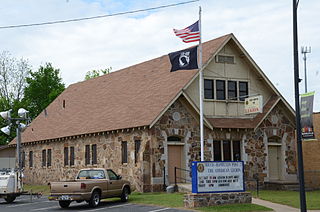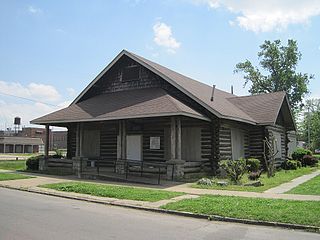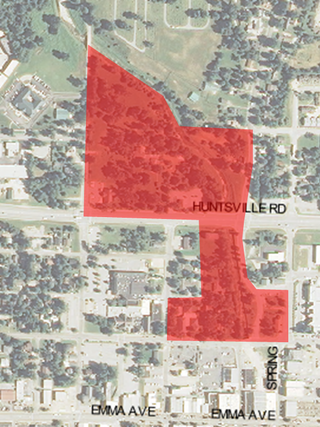Hall Morgan Post 83, American Legion Hut, in Rison, Arkansas, also known as Rison American Legion Hut, was built in 1934. It was listed on the National Register of Historic Places in 2003 and delisted in 2013.

The Jess Norman Post 166 American Legion Hut is a historic clubhouse at 222 South First Street in Augusta, Arkansas. It is a single-story rectangular log structure, with a gable roof and a stone chimney. It is fashioned out of cypress logs joined by square notches, and rests on piers of stone and wood. It was built in 1934 with funding from the Civil Works Administration for the local American Legion chapter, and is architecturally unique in the city. It is still used for its original purpose.

The Bunch-Walton Post No. 22 American Legion Hut is a historic social club meeting hall at 201 Legion Street in Clarksville, Arkansas. It is architecturally unique in the community, built out of native stone in the manner of a Norman castle. It is two stories in height, with rounded projecting corners and a crenellated parapet. Its main entrance is set in a rounded-arch opening at the center of the front facade, and is elevated, with access via flight of stairs. It was built in 1934, and is believed to be the only American Legion hall of this style in the state.

The American Legion Hut-Des Arc is a historic fraternal meeting hall at 206 Erwin Street in Des Arc, Arkansas. It is a single story rectangular structure, built of saddle-notched round logs, with a side-gable roof and a foundation of brick piers. The logs are chinked with large amounts of white cement mortar. The main facade is adorned with a massive fieldstone chimney, and has two entrances, each sheltered by gable-roofed hoods. Built in 1934, it is the only local example of the WPA Rustic style.

The Willie Lamb Post No. 26 American Legion Hut is a historic society meeting hall at 205 Alexander Street in Lepanto, Arkansas. It is a single story brick building with a side-gable roof, and a full-width shed-roof front porch supported by square posts. It was built in 1937-38 for the local chapter of the American Legion military fraternal organization, replacing an earlier building which had been built with funding assistance from the New Deal Civil Works Administration in 1932 which was flooded and then destroyed by fire. The building has long been a center of social activity in the community, as the site of dances, fundraising events, and other activities.

The W.R.C. Hall is an historic building located in Iowa Falls, Iowa, United States. Built in 1898, the building has segmented arched windows and a bracketed metal cornice, which are features of the Italianate style.

The Newport American Legion Community Hut is a historic log meeting hall in Remmel Park, north of Remmel Avenue, in Newport, Arkansas. It is a single-story structure, with a gable roof, and a front porch with a shed roof supported by log columns. The interior has retained all of its exposed log framing. A storage building, also built of logs at the same time, stands nearby. The hall was built in 1934 as part of the improvements to Remmel Park, and was designed to serve both the local American Legion chapter and the community.

The American Legion Post No. 121 is a historic social hall on Legion Hut Road in southern Paris, Arkansas. It is a single-story L-shaped structure, built out of notched logs on a stone foundation. The logs are painted brown, and are mortared with white cement. It has a gabled roof with exposed rafter ends. A gabled porch shelters the front entrance, supported by square posts set on concrete piers faced in stone. The building was constructed in 1934 with work crews funded by the Works Progress Administration, and is the best local example of WPA Rustic architecture.

WPA Rustic architecture is an architectural style from the era of the U.S. New Deal Works Project Administration. The WPA provided funding for architects to create a variety of buildings, including amphitheaters and lodges. WPA architecture is akin to National Park Service rustic architecture.

The American Legion Hut , also known as the Newton County American Legion Post No. 89 Hut, was built in 1934. With 24 acres (9.7 ha), it was listed on the U.S. National Register of Historic Places in 2007. It is significant for its Rustic style architecture as applied in Mississippi, which includes use of horizontal log walls, exposed rafters and trusses, and stone fireplaces.
The Estes-Williams American Legion Hut #61 is a historic clubhouse on AR 62/412 in Yellville, Arkansas. It is a single-story Rustic-style log building built in 1933-34 by the local chapter of the American Legion, with funding assistance from the Civil Works Administration. The building is roughly T-shaped, with small projecting sections at the front and rear. It has a cross-gable roof with extended eaves and exposed rafter tails supported by large knee braces in the Craftsman style. The building is also used by other veterans' and community groups for meetings and events.

The American Legion Hut in Tehlequah City Park, jct. of E Shawnee St. and N. Brookside Ave., in Tahlequah, Oklahoma was built in 1937 and was listed on the National Register in 2006. It reflects WPA Standardized Style and is also known as Rhodes Pritchett American Legion Hut Post 50 and served as a meeting hall.

The Carl L. Caviness Post 102, American Legion was built in 1925. It reflects Late 19th and 20th Century Revivals architecture and was designed by Chariton architect William L. Perkins. In its National Register of Historic Places nomination, it was deemed "a good example of the Revival styles popular in the 1920s", a well-preserved work by William L. Perkins and an illustration of "the importance of the American Legion in the social life of the community." It was named in honor of Carl L. Caviness who was the first Lucas county resident to be killed in action during World War I.

American Legion Hut is a historic clubhouse located at Hampton, Hampton County, South Carolina. It was built in 1933, and is a one-story, T-shaped cypress log building with a truss roof. The Hut was constructed as, and continues to be a meeting hall for the Hampton American Legion Post 108 as well as serving as a site for civic and social events. Local workers built the Hut supported by funds from the Reconstruction Finance Corporation during the Great Depression.

The Richard L. Kitchens Post No. 41 is a historic American Legion hall at 409 Porter Street in Helena, Arkansas. Built in 1922 to a design by a local Legionnaire, this Rustic log structure is supposedly the first American Legion hall to be referred to as a "hut", and is the oldest Legion building in the city. Its main block is built of donated materials, including the cypress logs forming its walls, and built by volunteer labor supervised by a local contractor and Legionnaire. A frame addition was added to the rear of the building in 1949, as were two shed-roof additions.
The Sink-Crumb Post No. 72 American Legion Hut is a historic American Legion hall at Second and Cherry Streets in Knobel, Arkansas. It is a single-story cypress log structure, with a corrugated tin roof, a Rustic form that was typical of Legion halls of the 1930s. The hall was built in 1933–34 with funding from the Federal Civil Works Administration for the local American Legion chapter, which had been founded in 1931, and has served as a center for its activities since then.

Shiloh Historic District is a historic area of downtown Springdale, Arkansas listed on the National Register of Historic Places. The district encompasses eighteen significant buildings within its 32 acres (13 ha), with eight having historic or architectural significance and twelve relating to the early commercial and industrial development of Springdale. Also included within the area are several roads of historic significance to the city. The district covers an area straddling Spring Brook, around which the community developed beginning in the 1830s, and is roughly centered on the 1870 Shiloh Church building, which is the community's oldest surviving building.
The Oak Grove Community House in Oak Grove, Louisiana, also known as Oak Grove Legion Hut, was listed on the National Register of Historic Places in 2016. The listing includes a Rustic-style Civil Works Administration-built American Legion hut and a park. The hut was built in 1932–33.

Gower Cemetery is a historic African American cemetery located in Edmond, Oklahoma. It was established in 1889 by a formerly enslaved couple named Ophelia and John Gower who allowed other families of color and indigent people to bury their dead on their land for free.

















